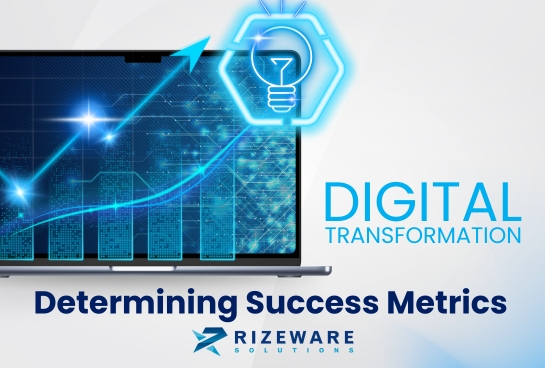Digital Transformation Blog Series – Erik Ruda, CEO, Rizeware Solutions
As we approach the end of this series on Digital Transformation, let’s pause and reflect on the journey thus far. We emphasized the need to start with a clear vision and strategy – and ensure your leadership team is aligned on that. The next step was to create a team that could manage the disruptive changes that inevitably result from this process. After that, we reviewed many of the issues to consider when upgrading your IT hardware, software, and services infrastructure. With a modern infrastructure in place, we then highlighted the opportunity to optimize your internal processes and workflows to fully achieve the goal of being a digitally powered business.
At this point, most of the hard work will have been completed, and it’s time to start evaluating the performance of your digitally powered organization. To get an accurate – and complete – view of your business performance, consider employing a set of metrics that are both quantitative (measured with a number or percentage) and qualitative (more subjective, but still valuable). Carefully choose the metrics that are most relevant to the structure, operation, and growth objectives of your business. Every business is different, so the appropriate set of metrics will be slightly (or significantly) different for each company.
By the way, your leadership team should agree on those specific metrics before embarking on your Digital Transformation journey. This is important because you’ll need to first establish a baseline for each metric that will be referenced after your journey is complete. In other words, you will want to create an accurate “before and after” picture to understand precisely how your Digital Transformation journey has impacted the performance of the business.
Given the collective time, effort, and money you’ve invested in your Digital Transformation journey by this point, there might be a temptation to choose only those metrics that will suggest amazing success. But if your journey started with a well-defined vision and strategy, amazing success should be your reality.
It’s also important to understand that the quantitative and qualitative values associated with each metric will likely change positively or negatively over time. That’s because your business is a living, evolving organism. For that reason, it’s best to perform metrics analysis on a quarterly basis. Even better, consider developing software that consolidates and continuously analyzes your key metrics, almost like a real-time business performance dashboard. That will allow you to “turn the dials” and make necessary mid-course corrections in specific areas of the business to ensure that your Digital Transformation investments continue to deliver maximum value.
OK, so now the question is, what specific metrics should you consider? The options are nearly limitless but for quantitative metrics, consider the following options and determine whether they are right for your business. Again, each of these should start with a baseline measurement before starting your Digital Transformation journey.
- Business revenue growth
- Market share growth
- Employee growth
- Revenue per employee
- Customer growth
- Revenue per customer
- Manufacturing productivity
- Number of new products or services
- Cost of goods
- Gross margins
- Profit margins
As noted earlier, qualitative metrics are more subjective, but they can be even more valuable in terms of providing strategic direction for your business. Here are a few examples.
- Employee satisfaction
- Customer satisfaction
- Product innovations
- Business agility
- Market expansions
- Geographic expansions
- Compliance requirements
- Digital literacy of employees
- Brand perceptions
- Digital ecosystem evolution
Hopefully these suggestions will inspire you to create your own metrics and encourage a deeper discussion in your organization. Remember, the goal is to achieve alignment not just on the core vision and strategy of your Digital Transformation initiative, but also the best metrics to evaluate your success and optimize your business growth path moving forward.

